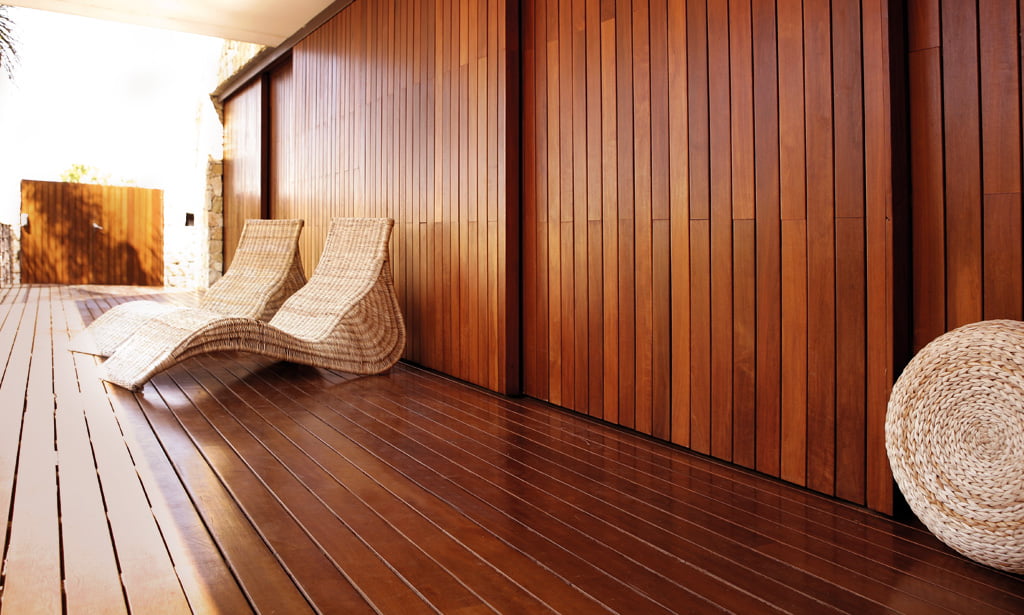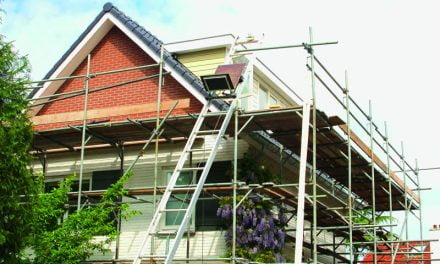A deck can add beauty and functionality to any home. In a climate like ours, a good deck can allow for many hours of outdoor enjoyment, from at-home entertaining to a quiet afternoon relaxing with a beer and the weekend newspaper.
Much like other aspects of home design, decking trends come and go, and vary from state to state. Paul Oorschot, director at the Timber Decking Supply Shed in Perth, has found that Western Australia is a very different market to the eastern seaboard, with Jarrah as the local favourite as far as decking goes.
“However, we are finding that Jarrah is being use more specifically in under cover alfresco and less in the more fully exposed locations,” he says. “This is mainly because it can be a little problematic due it being a Class 2 hardwood. The use of Merbau is also a very popular hardwood especially in the wide 140 x19 option. It’s very stable and well-suited for extreme locations both coastal and inland. It’s used extensively in the Kimberly area because it is very robust.
“The use of Spotted Gum and Blackbutt is also being used more in Perth for decking but generally this is the choice of the more environmentally conscious client, who wants something from a plantation-managed option.”
Get it right
Installed and treated right, a deck can last for many years. One of the most important things to understand with decking is that you should leave too much rather than too little space, says Gerry Swindale, president of the National Wood Flooring Association of Australia.
“Decks installed in leafy suburbs often have decks covered in gum nuts and debris,” he explains. “Decks with less than a 5mm expansion joint between every board often become clogged with debris that does not fall through the deck. This can cause expansion pressure between boards that can lead to complete decking failure. Such incidents can lead to complete deck replacement in some incidents.”
Keeping a timber deck looking good year after year is actually quite simple. If you apply a good oil- or water-based sealer every six months (Oorschot recommends doing so in April and November) this will keep most decks looking good. Extreme locations right on the coast may need extra, but self-assessment is the key here.
“We have used a water-based hydrophobic coating made by Crommelin for over 10 years,” Oorschot says. “We promote and sell it to all our DIY clients under own label. It’s been well tested over the last decade here in Western Australia and we love it. It’s easy to apply and will keep all surface dirt and water out.
The use of non-tinted oils such as Cutek and Organoil will also do a great job but more as a timber fibre preserver. These options are regularly used as pre-oil options by architects for commercial projects. Domestic and residential builders also use it for a more natural finish.”
One of the most common errors made by decking DIYers is site preparation and project planning. Many are building a deck for the first time and can get carried away in the excitement of building something for themselves. With so much information available on the internet (not all of it accurate or trustworthy) it can be easy to just stick to a plan and remember the basics.
“A deck has to be constructed to AS code and most people don’t follow this rule,” Oorschot says. “At the Timber Decking Supply Shed we have been actively involved in the construction industry since 1988 and have a good understanding of what is required to get it right from the start.
“The use of the correct structural treated pine and engineered hardwoods for any project installed correctly will last many years, and the right advice will be crucial to make it work. How much clearance should there be? What size footings will be required? What type of hardware is need for long term strength? These are only a few things to consider when taking on a DIY project.”
The wrong hardwood in the wrong position or location can end up being costly to fix or replace. Jarrah, Merbau, Spotted Gum, Blackbutt, Kapur, Kekatong and Batu are all very different timbers and will only perform best in the right location.
Australian plantation pine
Australian plantation pine is a sustainable, renewable and environmentally responsible resource that is becoming increasingly popular as a choice of decking.
“Australian plantation pine is third party certified as originating from 100 percent legally harvested forests,” says Trevor Innes, General Manager Technical and Environment at Timberlink Australia, which supplies Australian plantation pine decking. “All Timberlink pine is AFS/PEFC certified and comes with Chain of Custody (CoC) certification.”
Plantation pine trees (like all trees) absorb carbon from the environment and retain this carbon even once harvested and turned into finished products. Processing plantation pine uses substantially less energy than that required to produce other framing/decking materials such as steel or PVC composites.
“Being locally grown also reduces transportation costs,” Innes says. “Timberlink’s three mills (two in Australia and one in New Zealand) are all located next to our plantation pine resources.”
Australian plantation treated pine used for deck boards is one of the best value for money decking products available in the market. Both Australian and New Zealand plantation pine is commonly used for outdoor structures in Australia as it is readily and reliably available and has the environmental tick of sustainability.
“For outdoor structural applications, Radiata pine can be reliably and consistently treated to ensure durability for Australian conditions while being safe and easy to work with,” Innes says.
Outdoor timber (H3 Hazard Class, outside and above ground) needs to be treated to protect it against fungal and insect (including termite) attack. Timber sold for outdoor use is typically treated with CCA (Copper Chromium Arsenate), ACQ (Alkaline Copper Quaternary), or LOSP (Light Organic Solvent Preservative).
“Over the last five to 10 years the Australian industry (including Timberlink) has moved to using LOSP treatments, which were specifically developed for Australian conditions,” Innes says. “While the actual LOSP chemical is more expensive than other treatment chemicals, it is a dry treatment so the timber does not require redrying, saving on total energy costs. LOSP treatment puts the timber under less stress during production making it less likely to distort, resulting in a more dimensionally stable product.”
Timberlink’s Bell Bay mill produces a low odour LOSP option – the first treatment plant in the world to do so.
“With the same attributes as the standard LOSP treatments, the low odour version has been extremely successful for us due to the fact that it has up to thirty times less odour,” Innes says. “While the white spirits-type smell emanating from LOSP timber is not dangerous and does evaporate over time, we had found that many of our customers didn’t like the LOSP smell at all.
Outdoor timber that will be placed in the ground (H4 Hazard Class, outside in ground) requires different treatments, with CCA, ACQ and Tanalith E being the typical treatments used by the industry.
“Timberlink’s arrow posts are treated with CCA and are suitable for H4 applications,: says Innes. “We mould every arrow post after applying the outdoor treatment to ensure an ‘arrow-straight’ post every time.”
Of course, it’s also recommended that all timber in outdoor applications be finished with a suitable exterior paint or stain to help protect against long-term weathering and keep the project looking good for many years.
Top timbers for decking
Treated pine
Plantation Radiata pine is sustainable, renewable and environmentally responsible. A cheaper option than other timbers, but still an attractive addition.
Jarrah
Beautifully coloured, but a more expensive option. The timber’s high density makes it more resistant to fire, it can withstand extreme weather and is resistant to fungi and insects.
Blackbutt
Another dense, fire- and termite-resistant timber. Has gorgeous blonde tones and is more consistently coloured than other species. Should be sealed ASAP and resealed regularly to avoid cracking.
Spotted Gum
A popular Aussie hardwood that’s extremely dense, durable and a good choice for bushfire-prone areas. Can vary greatly in colour.
Merbau
Commonly imported from Southeast Asia, so look for sustainably harvested wood. Versatile, durable and termite-resistant, it’s also a very attractive timber that’s only slightly combustible.
Ironbark
One of the hardest timber species available. Ironbark is dense and heavy and also fire-, termite- and rot-resistant. A great choice for pool decking, and available in a range of colours, from pale brown through to a rich red.
Stringybark
Comes in white, yellow and red. Yellow is the best choice for decking as it’s more durable. Gum veins and worm holes can be quite common, which can provide a unique appearance.
Teak
More expensive than most other timbers, but extremely durable in extreme weather conditions. Often used in boat-building, this timber can last for a long time above ground (40 years or more). Termite-resistant and holds nails and screws well.
Tallowwood
Extremely hard, durable and versatile, with a long lifespan when used both above and below ground, Tallowwood has a unique colour and grain structure. Rot- and termite-resistant.
Composite decking
A wide variety of composite decking is available in Australia. Some customers prefer this product over timber due to composite decking’s low maintenance needs and standardised size and straightness. Also termite-, sun- and water-resistant.
How much decking do you need?
- Work out the size of your deck by multiplying the length by the breadth e.g. 10m x 3m = 30m2
- Decide which decking board size you will use, eg, 90x22mm
- Divide m2 by the decking board width (convert decking width from mm to m), eg, 30m2/0.09m = 334m
- Add an extra 5% just to be sure, eg, 334×1.05 = 351m
- For how many pieces of decking you need, divide this number by the decking lengths you have chosen, eg, 351m/5.4m = 65 pieces
- Therefore you would need to buy 65 pieces of 90x22x5.4 decking to cover a 10x3m deck.
Courtesy of Timberlink.com.au










